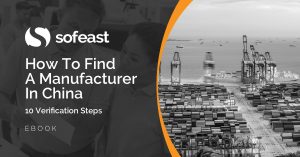You import from China. You sell to customers who want the right quality at the right time. You know that, if you can’t deliver, they will go elsewhere.
And, on the other hand, your suppliers say “we’ll try our best, don’t worry”. And you know that they are late, say, 40% of the time and that their products are substandard or defective 30% of the time. Oh, and they might subcontract production without telling you about it, which makes things even worse.
As an importer, you have to make an unreliable supply to meet capricious demand.
How can you make demand less capricious, and make supply more reliable? Here are my 5 tips.
1. Manage your customer’s expectations
First, if you allow a domestic customer to enjoy the type of prices that are possible only when buying in low-cost Asia, he should understand that he cannot count on 100% reliability. If he is not willing to give up some reliability (in a reasonable measure) in order to get low prices, you’ll have a hard time satisfying him.
Second, some customers have expectations that are even unrealistic in their own country. I was recently discussing with a French importer who was in this case. He was given a mission to find wooden pallets that could comply with very strict requirements. But even in France, no wood mill would accept size specifications with 0.5cm tolerances, and an AQL of 2.5%!
2. Pick better suppliers
Some suppliers in China are excellent and can be counted on. Some others are only capable of disasters. And the majority is somewhere between these two extremes.
I have written extensively about how to search for new suppliers. It takes time. It is often a trial-and-error process. The first thing to understand is that, in China, the cheapest supplier is not the most reliable.
Be ready to pay a little more, and try to build long-term relationships with good suppliers.
3. Last-minute surprises WILL happen
I remember an American client who said to me “I have been buying in China for 10 years, and every time there seems to be some new problem that I never dealt with before.”
You can take some elementary precautions to reduce the impact of these bad surprises:
- Add some padding in your schedule (at least 2 weeks, because you have to count on delays).
- Try to catch quality issues as early as possible. Inspect quality early in the production cycle, and of course again before shipment.
- If possible, keep a certain level of inventory in your warehouse, as a safety measure. There is a cost to it, but it is necessary until you can rely on your source.
4. Control your supply chain tightly
In the textile industry, which is a bit particular, I can distinguish three types of buyers:
The “wholesalers-importers”
They are based in the importing country and carry inventory. They typically purchase finished products under FOB terms and don’t control much about their supply chain. But it is not a big problem. They can tolerate a certain proportion of cancelled/delayed shipments, because of the stock they have in hand.
The “importers-traders”
This category is basically identical to “wholesalers-importers”, except that they don’t carry any inventory and they typically sell each shipment to one specific customer.
This is the riskiest situation to be in since they don’t have much control BUT they have no inventory buffer to keep a customer waiting in case of delays/cancellations.
The “producers-traders”
They control the supply chain as much as possible. Some of them produce in their own factory. Most of them purchase the materials, manage new developments and approvals, and then pay production workshops for the assembly job (that’s called “CMT” in that industry).
If a factory does not give satisfaction, the “producers-traders” can quickly switch production to another, more reliable one.
5. Use a legally-enforceable contract
When things start to go wrong, you need leverage to get the manufacturer back on track. If you have already pre-paid the whole amount and if they have chopped no OEM agreement, you are in big trouble.
I am not an expert on this subject. Consult with a lawyer who knows China business. A good contract can address all the sensitive issues. If you feel that you can force your suppliers to sign a contract, read more about this here.
*****
In short, if you don’t control your supply chain and if you don’t carry inventory, you need to monitor production closely, get a contract in place if possible, and manage your customers’ expectations… While slowly improving your supplier base.
Do you see other solutions? Let us know in the comments, please.
Are you wondering how to find a manufacturer in China who is well-suited to your needs and can also deliver on their promises?
Sofeast has developed 10 verification steps to help you find the right manufacturer. They’re shared in this FREE eBook: “How To Find A Manufacturer In China: 10 Verification Steps.”
It covers:
- Background checks
- Manufacturing capabilities
- Quality system auditing
- Engineering resources
- Pricing, negotiation, & contracts
- …and much, much more
Just hit the button below to get your copy:



Renaud, I don’t know if I see other solutions but I want to add commentary about carrying inventory and managing customer expectations. The company I work for imports some component parts, so it is a must that we carry inventory to respond quickly to customer demands. We pride ourselves on being responsive and we couldn’t do it without carrying inventory. To me inventory is necessary. Your comments on managing customer expectations is critical. Whenever we get swamped with a very large order that depletes our supply we make sure to inform our customers of the associated lead time they will face in completing their order. It doesn’t happen often, but you are correct in that you have to keep the customer informed and of course you have to build buffer time into your schedule because you never know what will happen on the other side of the world.
Rindge Leaphart
https://rindgeleaphart.wordpress.com/
Thanks a lot for sharing your experiences!